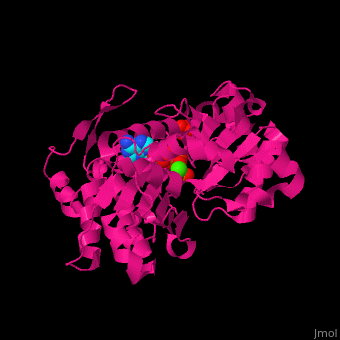|
|
| Line 1: |
Line 1: |
| <StructureSection load='3hbt' size='350' side='right' scene='' caption='Native G-actin with methyl-histidine complex with ATP, sulfate and Ca+2 ion (green) [[3hbt]]'> | | <StructureSection load='3hbt' size='450' side='right' scene='43/430015/Cv/3' caption='Native G-actin with methyl-histidine complex with ATP, sulfate and Ca+2 ion (green) [[3hbt]]'> |
|
| |
|
| == Function == | | == Function == |
Revision as of 17:44, 7 January 2016
FunctionActin is a protein found in all eukaryotic cells.[1] It is the monomer of two types of filaments: microfilaments which are part of the cytoskeleton and thin filaments which are part of muscles. Three isoforms of actin are identified: α (Aa) (or G-actin) found in muscle tissue, β (Ab) and γ (Ag) actins are components of the cytoskeleton. F-actin is Aa bound to ATP. For more details see:
*F-actin
*Non-polymerizable monomeric actin.
(PDB entries 1hlu and 2btf; morph was taken from Gallery of Morphs of the Yale Morph Server). Actin participates in muscle contraction, cell motility, cell division and cytokinesis. Actin associated with myosin is responsible for most cell movements.
DiseaseMutations in α-actin found in skeletal striated muscles can cause myopathy. Mutations in α-actin found in smooth muscles can cause thoracic aortic aneurism. Mutations in α-actin found in heart muscles can cause heart malfunctioning.
Structural highlightsActin binds ATP in a cleft. It changes its conformation upon hydrolysis of its bound ATP to ADP. Actin filaments are polar. They are formed with all monomers having their clefts pointing in the same direction.
| |
3D Structures of Actin3D Structures of Actin
Updated on 07-January-2016
{"openlevels":0}
- α actin 1 (Aa)
- 2w49 – cAa +troponin C+ troponin T+ troponin I+ tropomyosin α-1 – chicken
- 3j4k - cAa + tropomyosin
- 1mdu – cAa+hGelsolin
- 3j8a - mAa + tropomyosin - mouse
- 3hbt, 2zwh, 1nwk, 1j6z, 3g37, 2y83 – rAa – rabbit
- 4a7f, 4a7h, 4a7l – rAa + tropomyosin α-1 + myosin heavy chain (mutant) – Cryo EM
- 2q1n, 2q31, 2a5x, 1rdw, 1rfq, 1lcu – rAa – dimer
- 3mfp, 4a7n, 3j8i, 3j8j, 3j8k – rAa – Cryo EM
- 2q36, 1qz5 – rAa+kabiramide C – dimer
- 2hmp – rAa – protease cleaved
- 2zwh, 2gwj, 2gwk – rAa-ATP
- 2vyp – rAa+myxobacterial rhizopodin
- 2v51, 2v52, 2yje, 2yjf – rAa+mMKL/Myocardin-like protein – mouse (m)
- 2vcp – rAa+ neural wiskott-aldrich syndrome protein (hWASP) – human (h)
- 2a3z, 2a40, 2a41 – rAa+cDNase I+domains of hWASP – cow (c)
- 2ff3 - rAa+ hGelsolin +domains of hWASP
- 2a42 – rAa+cDNase I
- 4eah – rAa + formin-like protein 3 FH2 domain
- 3daw – rAa+mTwinfilin-1
- 3buz – rAa+Iota toxin component IA
- 3b5u – rAa filament – fiber diffraction
- 1eqy, 3cjb, 1p8z, 3ffk, 3tu5, 4pkg, 4pkh, 4pki – rAa+hGelsolin
- 4b1u, 4b1v, 4b1w, 4b1x, 4b1y, 4b1z – rAa + phosphatase and actin regulator
- 1rgi - rAa+hoGelsolin – horse (ho)
- 1t44 - rAa+hGelsolin:mThymosin β-4
- 4pl8 - rAa+ Thymosin β-4
- 3u8x - rAa+DmThymosin β-4 - Drosophila melanogaster
- 1esv - rAa+hGelsolin+ latrunculin A
- 3cjc - rAa+hGelsolin+cDNase I
- 2d1k - rAa+hWH2 domain of MIN+cDNase I
- 2pbd – rAa+hProfilin-1
- 2pav - rAa+hProfilin-1+hVASP
- 2q97 – rAa+toxofilin – Toxoplasma gondii
- 2q0r – rAa+pectenotoxin-2
- 2q0u - rAa+pectenotoxin-2+latrunculin B
- 1ijj - rAa+latrunculin A
- 2fxu – rAa+bistramide A
- 1wua – rAa+alpyronine A
- 2asm, 2asp – rAa+reidispongiolide
- 2aso – rAa+sphinxolide B
- 1yxq – rAa+swinholide A
- 1y64 – rAa+yBNI1 domain FH2 - yeast
- 1sqk – rAa+DmCiboulot
- 3sjh, 3u9d, 3u9z - rAa+DmCiboulot thymosin β-4 domain
- 4k41, 1qz6, 1s22, 4k42, 4k43 - rAa+ macrolide
- 3mn5 – rAa+ DmSpire WH2 domain
- 2ff6 - rAa+DmCiboulot+hGelsolin
- 1s22 – rAa+ulapualide A
- 1qz6 – rAa+jaspisamide A
- 1lot, 1kxp, 1ma9 – rAa+hVitamin D binding protein
- 3m1f – rAa+VOPL WH2 domain
- 3m3n – rAa+mN-WASP
- 3m6g – rAa+lobophorolide
- 3tpq – rAa + MAL RPEL domain
- 3ue5 – rAa + spire domain D
- 4gy2 – rAa + ι toxin component IA
- 4h0t – rAa + ι toxin component IA + ADPR
- 4h03, 4h0v, 4h0x, 4h0y – rAa + ι toxin component IA + NAD
- 4jhd – DmAa + protein cordon-bleu WH2 domain
- 4cbu – Aa + gelsolin – Plasmodium falciparum
- 4cbw – PbAa + gelsolin – Plasmodium berghei
- β actin (Ab)
- 3lue – hAb+hAlpha-actinin
- 3byh – hAb+hFimbrin ABD2 – Cryo EM
- 2oan – cAb
- 3j0s – cAb + cofilin 2
- 3u4l, 3ub5 – Ab + profilin-1 - bovine
- 4cbx – PbAb + gelsolin
- γ 1 actin (Ag)
- 1atn – rAg+cDNase I
- 3chw – Major DdAg+hProfilin+poly-Pro repeat – Dictyostelium discoideum
- 3ci5, 3cip, 1nmd - Major DdAg+hGelsolin
- 3a5l, 3a5m, 3a5n, 3a5o - Major DdAg+hGelsolin (mutant)
- 1c0g, 1dej – DdAg:tetrahymenatA+hGelsolin
- 1nm1 - DdAg+hGelsolin+Mg-ATP
- 1nlv, 1c0f – DdAg+hGelsolin
- 1d4x – Ag 1/3+hGelsolin – C. elegans
- 1h1v – hAg+rGelsolin
- 1hlu, 2btf – cAg+cProfilin
- 1o1g, 1o1a, 1o1b, 1o1c, 1o1d, 1o1e, 1o1f, 1o18, 1o19, 1mvw, 1m8q –cAg+cMyosin II - tomography
- 3eks – DmAg 5c (mutant)
- 3eku – DmAg 5c (mutant)+cytochalasin D
- 3el2, 2hf4 - DmAg 5c (mutant)+Ca-ATP
- 2hf3 - DmAg 5c (mutant)+Ca-ADP
- 3w3d – cAg + DNase I
- 3b63 – actin filament – Limulus polyphemus
- 1yvn – yA (mutant)+hGelsolin
- 1yag - yA+hGelsolin
- 3mmv – DmA-5C+spire WH2 domain
- 3mn6, 3mn7, 3mn9 - DmA-5C (mutant)+spire
- 4efh – A + spire domains C,D – Acanthamoeba castellanii
ReferenceReference
- ↑ Otterbein LR, Graceffa P, Dominguez R. The crystal structure of uncomplexed actin in the ADP state. Science. 2001 Jul 27;293(5530):708-11. PMID:11474115 doi:10.1126/science.1059700
